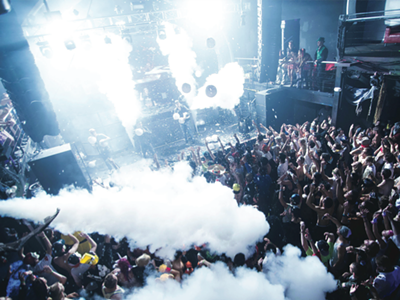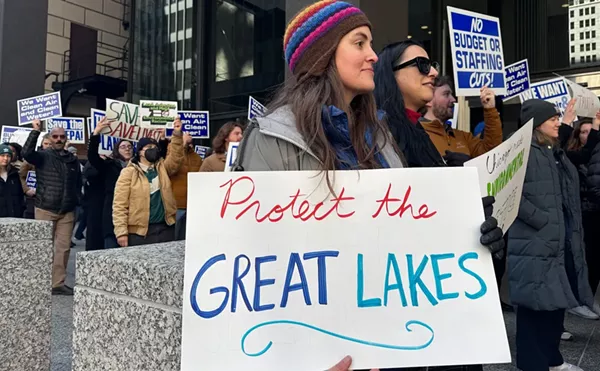Everything changes. Nothing stays the same and, to a large extent, how well you do in life is an outgrowth of how you manage change.
Certainly big changes are afoot in Detroit with the city’s bankruptcy — not all change is good, but it must be managed. Detroit was once agricultural before it became a Great Lakes shipping center. Then it became the Motor City. Eventually it had to become something else. What that something else will be remains to be seen.
The Heidelberg Project on Detroit’s east side is a microcosm of managing change that is forced upon you. Over the past year, fires, which officials consider arson, have destroyed five houses of the internationally renowned art village. As devastating as that is, it has not knocked artist Tyree Guyton much off his game. The Heidelberg Project was built on devastation, and, as challenging as these fires have been, ultimately, it’s more grist for the mill.
“We’re great,” says Jeanine Whitfield, director of the Heidelberg Project. “I think that other people really have a much more difficult time with the fires than we anticipated. Tyree Guyton is of the neighborhood, and there was never anyplace to go except up, which means that we are accustomed to adversity and we are very experienced at rising above it. We look for opportunity out of this adversity. That is what we have done and will continue to do. Someone transformed the Heidelberg Project again, this time by fire.”
Guyton began the project out of necessity, trying to do something about what was going on in his neighborhood. It didn’t come from some art-school concept, although it has captured the attention of schooled artists around the world. The art was his natural response to the decay and degradation to the life that he knew. It’s a personal thing. He first began the project in 1986 with his grandfather Sam Mackey, his former wife, Karen, and some neighborhood kids. The conceptual infrastructure has followed him. Now there are other artists who are part of what has essentially become a conceptual village.
And the project has coined and copyrighted a new word: Heidelbergology.
It means “the study of artistic materials (i.e. found objects) incorporated into the fabric and landscape of an urban community and the effects on that community,” Whitfield says. “We’ve got 28 years of anecdotes that support that definition.”
Whitfield says there are three practices that grow from that definition: art as medicine, art as a catalyst for social and economic development, and abstract advocacy, information that changes attitudes in the short term, and that, in the long term, changes behavior.
She cites the case of Mrs. Bell, a neighbor on Heidelberg Street who fought the Project for 25 years. Now most days she sits on her front porch greeting visitors to the site, offering them the opportunity to sign their names on her house in exchange for a small donation.
“We welcome neighbors to come up with their own concept of how they can make this project work for them,” says Whitfield.
The project has an education coordinator and a gift shop. Its office has moved from a Midtown location to a refurbished house on another street in the neighborhood. It’s growing slowly, but there is growth. It’s not the only funding the place has received, but this spring the Michigan Council for Arts and Cultural Affairs granted it $19,000 in operational costs and another $2,000 for programming.
The neighborhood around the project is run-down. Much of it looks like the worst areas of Detroit. Most of us have seen those areas, and there is little reason to detail this and that at the moment. But Heidelberg has given pride and hope to many in the area. One of their own has risen up and done something that has captured imaginations around the world.
There are no big-bucks developments nearby such as in downtown or Midtown. There are no big anchor institutions such as the corridor between the University of Detroit Mercy and Marygrove College that can at least whet the appetite of someone thinking about development. There isn’t even an organized blight-busting effort like the one that targeted 21 blocks in Brightmoor last winter. Urban gardening is popping up here and there, but it’s a slow go because of lead contamination in the soil.
The Heidelberg Project is the neighborhood anchor. The project’s history shows how tenuous that can be. When it first started, complaining neighbors got the ear of then-mayor Coleman Young, who bulldozed it in 1991. Heidelberg bounced back. Mayor Dennis Archer tried to demolish it again in 1999. Now these fires — no one has been arrested in the arsons — challenge it again. But like the mythological Phoenix of antiquity, Heidelberg rises from the ashes.
“What I’m excited about is the fact that as a result of the fires we have been able to reintroduce that community to fuller life,” Whitfield says.
It’s not just fire. It’s everything that happens there. Not long ago, someone dropped a huge, large-screen TV on Heidelberg Street. Guyton studied it for a while and came up with the idea of the Heidelberg Television Show. The empty framework of the television sits in a lot with rabbit ears and knobs. There is no screen but one can look through it and see a real reality show — not the ones proffered on cable channels that are anything but real. Guyton has sat behind the frame and addressed schoolchildren who visit the site and sit in front of the television to interact with him.
“It’s an example of how we’re re-energizing the site,” Whitfield says.
It has become a lesson for others, and has put out tendrils in other areas of Detroit. This spring, students at Cass Tech High School created a musical show inspired by the project titled Out of the Ashes. It addressed themes such as dreams, experiencing change, time, and success.
There’s inspiration to be found there and maybe some lessons for the rest of the city. Look around you and build on what’s at hand. Don’t wait for the cavalry to ride in to save you. It’s not coming.
I see similar inspiration in the Artists Village over at Lahser Street and Grand River Avenue, the Earthworks Urban Farm connected with the Capuchin Soup Kitchen, the recently established Boggs Educational Center and the work done by the Central Detroit Christian nonprofit north of the New Center. They’ve all looked around, seen what resources were at hand and, moved forward with positive ideas.
Over at the Heidelberg Project, things seem more volatile with one or more people out to bring it down. You might be able to bring the Heidelberg Project down, but you can’t keep it there.
That’s another larger lesson about Detroit.







